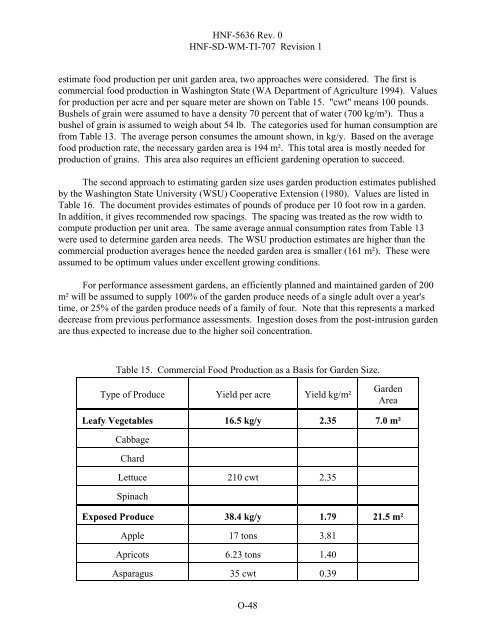appendix o exposure scenarios and unit dose factors ... - Hanford Site
appendix o exposure scenarios and unit dose factors ... - Hanford Site
appendix o exposure scenarios and unit dose factors ... - Hanford Site
Create successful ePaper yourself
Turn your PDF publications into a flip-book with our unique Google optimized e-Paper software.
HNF-5636 Rev. 0<br />
HNF-SD-WM-TI-707 Revision 1<br />
estimate food production per <strong>unit</strong> garden area, two approaches were considered. The first is<br />
commercial food production in Washington State (WA Department of Agriculture 1994). Values<br />
for production per acre <strong>and</strong> per square meter are shown on Table 15. "cwt" means 100 pounds.<br />
Bushels of grain were assumed to have a density 70 percent that of water (700 kg/m³). Thus a<br />
bushel of grain is assumed to weigh about 54 lb. The categories used for human consumption are<br />
from Table 13. The average person consumes the amount shown, in kg/y. Based on the average<br />
food production rate, the necessary garden area is 194 m². This total area is mostly needed for<br />
production of grains. This area also requires an efficient gardening operation to succeed.<br />
The second approach to estimating garden size uses garden production estimates published<br />
by the Washington State University (WSU) Cooperative Extension (1980). Values are listed in<br />
Table 16. The document provides estimates of pounds of produce per 10 foot row in a garden.<br />
In addition, it gives recommended row spacings. The spacing was treated as the row width to<br />
compute production per <strong>unit</strong> area. The same average annual consumption rates from Table 13<br />
were used to determine garden area needs. The WSU production estimates are higher than the<br />
commercial production averages hence the needed garden area is smaller (161 m²). These were<br />
assumed to be optimum values under excellent growing conditions.<br />
For performance assessment gardens, an efficiently planned <strong>and</strong> maintained garden of 200<br />
m² will be assumed to supply 100% of the garden produce needs of a single adult over a year's<br />
time, or 25% of the garden produce needs of a family of four. Note that this represents a marked<br />
decrease from previous performance assessments. Ingestion <strong>dose</strong>s from the post-intrusion garden<br />
are thus expected to increase due to the higher soil concentration.<br />
Table 15. Commercial Food Production as a Basis for Garden Size.<br />
Type of Produce Yield per acre Yield kg/m²<br />
Garden<br />
Area<br />
Leafy Vegetables 16.5 kg/y 2.35 7.0 m²<br />
Cabbage<br />
Chard<br />
Lettuce 210 cwt 2.35<br />
Spinach<br />
Exposed Produce 38.4 kg/y 1.79 21.5 m²<br />
Apple 17 tons 3.81<br />
Apricots 6.23 tons 1.40<br />
Asparagus 35 cwt 0.39<br />
O-48

















